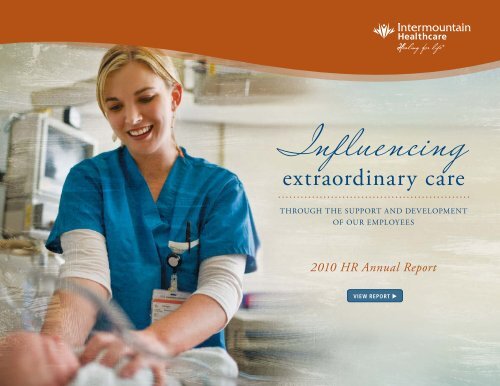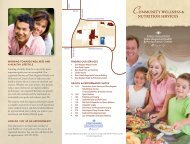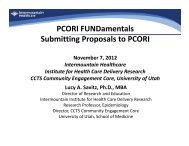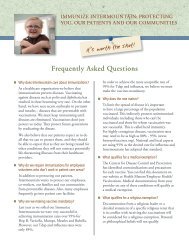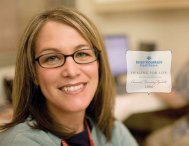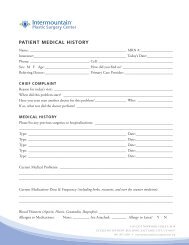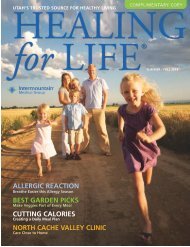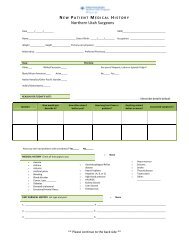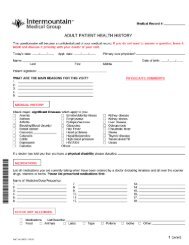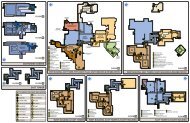2010 HR Annual Report - Intermountain Healthcare
2010 HR Annual Report - Intermountain Healthcare
2010 HR Annual Report - Intermountain Healthcare
- No tags were found...
Create successful ePaper yourself
Turn your PDF publications into a flip-book with our unique Google optimized e-Paper software.
Influencingextraordinary carethrough the support and developmentof our employees<strong>2010</strong> <strong>HR</strong> <strong>Annual</strong> <strong>Report</strong>1
<strong>2010</strong> <strong>HR</strong> <strong>Annual</strong> <strong>Report</strong>Inside the <strong>HR</strong> <strong>Annual</strong> <strong>Report</strong>Welcome to the <strong>2010</strong> <strong>HR</strong> <strong>Annual</strong> <strong>Report</strong>.The year was filled with many activitiesand accomplishments, along with trainingand development to support our leaders andemployees. Many of the initiatives you’ll readabout support our employees and help theirfocus on extraordinary care.3 Sourcing an Integrated Talent Management System4 CNO Leadership Development6 Employee Health Immunizations7 <strong>HR</strong> Training Approach and the Revenue Cycle Organization9 Preparing for 2011 Open Enrollment11 Medical Group Physician Leadership Development12 Change — Let the Adventure Begin14 Creating a Vision for Education16 Supporting Leaders with New Leader Orientation17 <strong>Intermountain</strong> Medical Center Creates Diversity Council19 Pay Increases and Thank You Checks20 Influencing Engagement with Resources on the Intranet21 New Site for a New Year22 Smooth Moves for SelectHealth24 <strong>HR</strong> Workforce Solutions & Analytics Team Members Earn <strong>HR</strong>IP Certification25 <strong>HR</strong> Team Members Earn Professional Certifications in Human Resources26 Human Resources Leadership Team (<strong>HR</strong>LT) Members27 <strong>2010</strong> Facts and Figures2
<strong>2010</strong> <strong>HR</strong> <strong>Annual</strong> <strong>Report</strong>Sourcing an Integrated TalentManagement SystemIn <strong>2010</strong> our <strong>HR</strong> Workforce Solutions and Analytics team partneredwith Organizational Effectiveness and the SCO to purchase anIntegrated Talent Management System. This new systemwill be used for recruiting, performance management,career planning, succession planning andcompensation administration.Welcome Talent LinkDuring the selection process the team focused on finding a systemwith high usability and deep functionality. The team wanted a systemthat would be ease for users to:• navigate• find information• complete required tasksIn addition, the system would need to be flexible and support ourtalent management needs.When Talent Link is fully operational, all of the differentemployee processes from recruitment and hiring, throughperformance reviews, individual development, successionplanning and compensation are aligned under in onesystem.Dan ZuhlkeSelecting Talent Linkand the redesign of ourPerformance ManagementprocessIn 2011, we’ll bring Talent Link recruitment online andmove our hiring process from Taleo. Over the next 2-3years we will continue to bring succession planning, careerplanning and compensation into Talent Link.3
<strong>2010</strong> <strong>HR</strong> <strong>Annual</strong> <strong>Report</strong>CNO Leadership DevelopmentIn 2008 Nancy Nowak, VP Clinical Operations and ChiefNursing Officer, sought to develop a pool of qualifiedcandidates for Chief Nursing Officer roles. Nancy knew itwas important to promote CNOs internally, recognizing theimportance of sustaining <strong>Intermountain</strong>’s vision, mission andvalues. Internal candidates support Extraordinary Care, and areintegrated with all its dimensions and values prior to promotionto a larger role, enabling cultural continuity within thesystem. It is also important for internal leadership to knowthat there are opportunities to learn, grow and be promotedwithin <strong>Intermountain</strong>.Partnering with OrganizationalEffectivenessTo start the process, Nancy partnered with <strong>HR</strong>’sOrganizational Effectiveness department. A needs assessmentwas conducted to determine the competencies, skills,abilities and personal attributes required of someone in thatrole in three years time. The model was validated by theCouncil of Chief Nursing Officers and the <strong>HR</strong> LeadershipTeam. Based on that model, CNOs recommendedcandidates to participate in the development. Nancy, theregional CNO, and <strong>HR</strong> Director interviewed each candidateto ensure they met the requirements, they were interestedand committed to nursing and becoming a CNO, and to setexpectations for participating in the program.“I was just offered and acceptedthe CNO position here at PCMC.I’m excited and nervous at thesame time, but ready for thechallenge. Thank you to all ofmy wonderful mentors. Thisprogram clearly helped prepareme for my new role.”judy geiger• • •4
<strong>2010</strong> <strong>HR</strong> <strong>Annual</strong> <strong>Report</strong>In March 2009 the group initiated a multi-rater feedback process, and thenbegan meeting in May as a team. Over the next 18 months the group met fortwelve sessions with <strong>Intermountain</strong> leaders facilitating the learning. Topicsincluded leadership, IT, Finance, Human Resources, Physician Relations, andothers—all focused on the role of the CNO in this function across the system.The capstone class was a Case Study program with each of the RVPs fromaround the system, discussing relevant topics such as nurse-physician relations,budgetary challenges, employee engagement and decision rights.“To be part of this experience as the CNO of <strong>Intermountain</strong> hasbeen rewarding in so many ways. I’ve had the opportunity tohelp build a new set of nursing leaders for <strong>Intermountain</strong>, toassure that our core mission continues into the future. These 10leaders came with great skills, have developed new ones of thelast two years, and have melded together as a team to supporteach other now and in the future. It has been my privilege tolead this program.” Nancy NowakThis program’s success isattributed to a few keyelements.• The systematic selection process forcandidates and the initial meeting wheretime was spent on team formation to createa safe learning environment• The combination of theory and practicalapplication thanks to the <strong>Intermountain</strong>leaders facilitating the learning• System-wide support by both CNOs andhospital administrators for nursing leadersin the program to leave behind their workand focus on their personal development.Program members also participatedin the Institute’s mini-ATPprogram in the fall of 2009completing projects together whichsupported the nursing strategicplan and its goals. They completedindividual projects in <strong>2010</strong> to applysome of the skills learned duringthe program in their current rolesas nursing leaders. Graduation washeld in November <strong>2010</strong> and thegroup couldn’t say enough aboutthe value they took away from theexperience.Beyond classroom learning,participants created a strong peernetwork to rely upon in theircurrent roles. They offered feedbackabout standardizing process andthe value of being a system ratherthan a standalone hospital facility.In addition the exposure to theperspectives and challenges indifferent locations helped to createa strategic focus in current rolesso that nursing across the systemis strengthened even when leaderscontribute most regularly within afacility.In 2011 a similar programwill begin to developRegional Chief FinancialOfficers, under theguidance of Greg Johnson.5
<strong>2010</strong> <strong>HR</strong> <strong>Annual</strong> <strong>Report</strong>Employee HealthImmunizationsTo protect our patients and our coworkers fromserious infections, <strong>Intermountain</strong> implemented anImmunization Policy in January <strong>2010</strong> for all employeesand volunteers. The new policy required all employeesand volunteers to meet the <strong>Intermountain</strong> <strong>Healthcare</strong>Immunization Requirements.immunizeWhat a success!The <strong>2010</strong> Immunize <strong>Intermountain</strong> Campaign was a great success. Becauseof employee efforts, <strong>Intermountain</strong> set the industry standard with ourImmunization Policy and vaccination rates. <strong>Intermountain</strong> was recognizedby The Joint Commission for being a model organization in protecting ourpatients and co-workers through vaccination.<strong>2010</strong> Vaccination/Immunization RatesEmployeesVolunteersChicken Pox 99.7% 95%Hepatitis B* 91% 86%Influenza† 86% 76%did you know?In <strong>2010</strong> we conducted16,959 TB Tests and15,302 blood draws fortests and administered45,717 vaccinations!<strong>Intermountain</strong>Measles 98% 87%Mumps 92% 85%Rubella 98% 86%Tdap 85% 63%6
<strong>2010</strong> <strong>HR</strong> <strong>Annual</strong> <strong>Report</strong><strong>HR</strong> Training Approach and theRevenue Cycle Organization (RCO)In late 2008 the Revenue CycleOrganization (RCO) announcedplans to consolidate and realignreporting relationships andorganizational structures. The RCOvision included realignments inmanagement structures for PatientAccount Services (PAS), RevenueIntegrity, and Health InformationManagement (HIM). Changes inmanagement and line reportingrelationships from each of thehospitals to the central RevenueCycle management structurewere made. The new structurealigned over 1,400 FTE’s into anorganizational structure that’sbetter positioned to consistentlyserve the needs of our patients,and the <strong>Intermountain</strong> system.Facing challenges with the new realignmentThe new centrally aligned RCO management structurepresented several challenges as employees were asked to adaptto the new structure and culture. Pre-service Patient Accessand Billing services were collapsed into four regional locations.Regional Revenue Integrity teams expanded their scope ofresponsibility, and the HIM enterprise coding model continuedto require coders to expand their support from their homelocation to other locations in need of help.During all of this, Management continued to accept new rolesand accountability for new employees. RCO leadership waschallenged to create a culture that supported this new structurein a consistent way, giving management access to resources andtools that would help them deal with change and allow them toengage employees through the transition.transitioningThe transition of both managementand staff to the new RCOstructure was smooth with verylittle business interruption.This transition included severalphysical relocations, and changesin reporting relationships. Leaderswith expanded roles continue tothrive in the new environment,which is a direct result of thecollaborative work between theRCO, <strong>HR</strong>, EAP, and OrganizationalEffectiveness during the transition.• • •7
<strong>2010</strong> <strong>HR</strong> <strong>Annual</strong> <strong>Report</strong>leadership forum• • •Around 160 leaders attended a one dayLeadership Forum in October. Those inattendance had the opportunity to interactwith other system RCO leaders, gainclarity around the vision of RCO cultureand outcomes, broaden their perspective of<strong>Intermountain</strong>, and develop and supportskill sets and that influence ExtraordinaryCare.Information from Greg Poulsen,Organizational Effectiveness, Rounding,and Financial Training was shared insessions. The day was a huge success andmany employees requested additionaltraining days in the future.<strong>HR</strong> supports this part of the business with an effectivetraining approach• In <strong>2010</strong>, the Employee Assistance Program, Organizational Effectiveness, and <strong>HR</strong>collaborated with RCO Leadership to construct training forums that would educate thedifferent teams on the emerging culture.• In addition, <strong>HR</strong> developed training plans that focused on the specific needs of differentemployee groups within the RCO in order to address concerns, and improve communicationchannels. Specific management training sessions were coordinated by <strong>HR</strong> that assessed teamstrengths, weaknesses, opportunities and threats to consider during the transition.• <strong>HR</strong> evaluated site specific training programs to determine how best to support the needs ofthe employees at different locations, while also supporting the overall mission of the newlyorganized RCO.RCO Tiered Training ApproachCollaboration and training approachbring positive resultsHuman Resources and Organizational Effectivenessworked together to conduct a needs assessment, developan education plan and to help move this group throughcentralizing the structure.“Tier training” divided leadersinto training groups based ontheir levels of responsibility in theorganization. Leadership groupswere defined in the following tiers:Tier 1EmployeesTodd Craghead and hisdirect reportsTier 2 The direct reports to Tier 1(directors and managers)Tier 3The direct reports toTier 2 (managers andfrontline supervisors)Training Hours• Encompasses 28 leaders• To date each leader has engaged inmore than 50 hours of education,development, and coaching.• Encompasses almost 140 leadersacross all regions.• Leaders are responsible to meet theRCO training requirements as wellas the training requirements of theregions where they work• Individuals at this level have averaged15-20 hours of RCO training perperson.8
Select Med Plus $250(16,262 employees enrolled)Select Care Plus $500(1,998 employees enrolled)Select Med HealthSave(3,364 employees enrolled)What did Open Select Enrollment Med Non-Deductible look like in <strong>2010</strong>?84%(412 employees enrolled)During Open Enrollment, 84% ofbenefits-eligible employeesenrolled in a health insurance plan,while 16% didn’t enroll. There were26,348 benefits-eligible employees.16%Select Med Plus $250(16,262 employees enrolled)Select Care Plus $500(1,998 employees enrolled)Select Med HealthSave(3,364 employees enrolled)Select Med Non-Deductible(412 employees enrolled)9%Select Select Med Med Plus Plus $250 $250(16,262 (16,262 employees employees enrolled) enrolled)Select Select Care Care Plus Plus $500 $500(1,998 (1,998 employees employees enrolled) enrolled)Select Select Med Med HealthSave HealthSave(3,364 (3,364 employees employees enrolled) enrolled)Select Select Med Med Non-Deductible Non-Deductible Select Med Plus $250(412 (412 employees employees enrolled) enrolled) (16,262 employees enrolled)15% 2%74%<strong>2010</strong> <strong>HR</strong> <strong>Annual</strong> <strong>Report</strong>Select Care Plus $500(1,998 employees enrolled)Select Med HealthSave(3,364 employees enrolled)Select Med Non-Deductible(412 employees enrolled)How many employeesenrolled in dental insurance?22,043 employees22,043 employees2,856 employeesenrolled in a Healthenrolled in a Healthenrolled in a HealthInsurance Number of PlanInsurance Planemployees that enrolled Savings one of Account theouttwoofdental26,348plans:benefitsoutof 26,348 benefits-(HSA) out of 3,364eligible employees.eligible employees.employees who wereeligible to enroll. 87%Number of employees that enrolled in theDental Plan:Number of employees that enrolled in theDental Plan + Ortho:24%76%9,0442,856employeesemployeesenrolledenrolledinin a HealthFlexibleSavingsSpendingAccountAccount(HSA) outoutofof3,36426,348employeesbenefitswho wereeligibleeligibleemployeesto enroll.22,043 22,043 employees employeesenrolled enrolled in a Health in a HealthInsurance Insurance Plan Planout of out 26,348 of 26,348 benefits- benefitseligibleeligible employees. employees.How many employees enrolled in anHSA or FSA account?9,044 employeesenrolled in aFlexible SpendingAccount out of26,348 benefitseligible employees85%2,856 2,856 employees employeesenrolled enrolled in a Health in a HealthSavings Savings Account Account(HSA) (HSA) out of out 3,364 of 3,364employees employees who were who wereeligible eligible to enroll. to enroll.34%9,044 9,044 employees employeesenrolled enrolled in a in aFlexible Flexible Spending SpendingAccount Account out of out of26,348 26,348 benefits benefitseligible eligible employees employees22,043 employeesenrolled in a HealthInsurance Plan2,856 employeesenrolled in a Health9,0410enro
<strong>2010</strong> <strong>HR</strong> <strong>Annual</strong> <strong>Report</strong>Medical Group PhysicianLeadership DevelopmentIn <strong>2010</strong>, in partnership with the University of Utah’sSchool of Business, <strong>Intermountain</strong> Medical Groupdeveloped a six-day leadership development programfor physician leaders. This year is the second year thatthe program has been available. The intent of theprogram is to enhance our physician leaders’ businessknowledge around key leadership competencies“There is incredible wisdomin the Medical Group’sinvestment in the developmentof our physician leaders. Thiscollaborative partnership withthe University of Utah is anincredibly powerful way ofcombining the knowledgefrom world class faculty at theUniversity of Utah with theexpertise of individuals who aredistinguished in their profession.It has been an incrediblysuccessful joint venture.”John OstromEnhancing Leadership CompetenciesThe program includes businessknowledge around key leadershipcompetencies including: InterpersonalCommunication, Strategic Planning,Brand Awareness & Marketing,Leadership, Human Resources,Collaborative Negotiations, andAccounting & Finance. Participantsincluded existing physician leaders andothers identified as potential futureleaders from across <strong>Intermountain</strong><strong>Healthcare</strong>.This broad representation has contributedto dynamic discussions with variedperspectives and experiences lending tothe learning experience. Participants areprovided pre-reading assignments, casestudies and other materials to provide themwith the most current research and businesscase studies available.The program is taught by the University ofUtah’s MBA faculty, in partnership with<strong>Intermountain</strong> Senior Leaders, who arecontent experts in their respective fields. TheUniversity of Utah faculty partnered withour own organizational experts, including:Dean Sanpei, <strong>Intermountain</strong> AssistantVice President, Strategic Planning, BruceJensen, <strong>Intermountain</strong> Vice President,Communication, Dr. Linda Leckman,Medical Group C.E.O., David Erickson,<strong>Intermountain</strong> Legal Counsel, Mike Weed,Medical Group Chief Financial Officer,and John Ostrom, Medical Group HumanResources Director.11
<strong>2010</strong> <strong>HR</strong> <strong>Annual</strong> <strong>Report</strong><strong>2010</strong> <strong>HR</strong> Education DayCHANGE – Let the Adventure Begin!The objective for <strong>HR</strong> Education Day was to understand how <strong>HR</strong> functionscan support <strong>Intermountain</strong> <strong>Healthcare</strong> with healthcare reform. The planningcommittee created an atmosphere of adventure based around the themeCHANGE—Let the adventure begin using Indiana Jones movie clips, quotesand props for all educational offerings.• Greg Poulsen, Sr. Vice President & Chief Strategy Officer, gave an overviewof national healthcare reform and discussed possible implications to<strong>Intermountain</strong>.• Dan Zuhlke, Vice President <strong>HR</strong>, focused his remarks on how these changeswill influence the <strong>HR</strong> team and our need to be efficient and effective in ourwork processes.12
<strong>2010</strong> <strong>HR</strong> <strong>Annual</strong> <strong>Report</strong>We had presentations from our compensation and benefits teamsaddressing future considerations for total compensation.Afternoon sessions provided learning in the following topics areas:Influencing Internal Customers; Kronos Workforce Scheduler;Performance Management; Personal Productivity; and, HealthInsurance during times of Reform.Our day ended with the large group hearing from CharlesMcClendon, the Gallup Organization, on each individual’s path tomaximizing engagement.For our service project, <strong>HR</strong> teams provided poster boards of theiractivities this past year to give back to their communities. These wereon display throughout the day for all to review and recognize thegreat work of these groups.Recognizing <strong>HR</strong> ServiceExcellence<strong>HR</strong> staff members whodemonstrated a strong commitmentto <strong>HR</strong> service excellence thispast year were recognized.Award recipients included:• Val Dredge, PCMC• Vickie Hardman, DRMC• Sharon Washington, AFH• D’Nell Gillespie, ESC• Tonya Swan, LRH• Brenda Voisard, Ph.D., UCR13
<strong>2010</strong> <strong>HR</strong> <strong>Annual</strong> <strong>Report</strong>Creating a Vision for EducationIn 2008 <strong>Intermountain</strong> <strong>Healthcare</strong> set a boardgoal to find efficiencies in Human Resourcesand Finance, surfacing best practices andmaximizing resources as a part of the servicedelivery to the organization. Education washighlighted as an area of opportunity, and<strong>Intermountain</strong> education leaders have sincefocused on creating a new vision, a stronggovernance structure, consistent job roles andresponsibilities, and open communicationschannels to better coordinate education acrossthe system.The Region Education Directors created a vision foreducation to guide this work:Extraordinary care through meaningful education:• Competency• Quality• EfficiencyThe <strong>Intermountain</strong> University team in the central office takes great care inproviding quality education to our employees. <strong>Annual</strong> education modulesare interactive, and the content is refreshed to ensure employee engagementin their learning. In addition, new development techniques are being usedto improve clinical outcomes with critical modules.One example is the Sedation Analgesia module, launched in <strong>2010</strong>. Jill Terry,Instructional Designer, partnered with Jeanne Nelson, Quality and PatientSafety Consultant. Together they took three modules totaling over thirtyscreens and converted the content to one interactive module with two authenticscenarios. This is the first time at <strong>Intermountain</strong> <strong>Healthcare</strong> using ablended learning approach.• • •Mark LemonBest practices ineducation and this year’saccomplishments14
<strong>2010</strong> <strong>HR</strong> <strong>Annual</strong> <strong>Report</strong> The module takes place in anonline patient room, illustratedby Jill Rhead, to be as real tolife as possible.Why this module?The collaboration across departments is essential fora successful project of this nature. Jill returned froma conference excited about work and she wantedto apply some of her new skills. Jeanne is a greatpartner as a subject matter expert—reliable, clear,and timely in meeting deadlines. Together theyworked through a longer design and developmentcycle to ensure a high quality learning experience forour nurses.What’s different?On the education design side, creating thisinteractive module took Jill two to three timesmore development time to ensure theinteraction was coded properly, andthat the interaction for the nurse withthe module was realistic. Feedbackto improve the current module wasprovided by bedside clinicians. Given thecomplexity of the input from this group,work on the module started earlier inthe design cycle, and a sedation task forcewas created to focus on the project andincorporate the required regulations.The group communicated regularlywith the Strategic Clinical EducationTeam, Region Education Directors,Region Education Consultants, QualityDirectors to ensure complete understanding of theprocess and the desired outcomes.On the learning side, learners focus on learningby doing rather than learning by informing. Careproviders print charting forms that are used forrealistic practice while working through the onlinemodule. This learning approach brought thelearning environment close to what they will beasked to accomplish at the bedside. The moduletakes place in an online simulation of a patientroom, illustrated by Jill Rhead, to be as realistic aspossible.One cannot click through the screens, but has towork through the scenarios in order to progressthrough the lesson. Jill and Jeanne wanted thelearning to require attention and thought ratherthan be a reading exercise.What was the result?Because there are significant differences in themodule from what learners are used to interactingwith, the module was piloted with front line staffat a few facilities before launch. The feedback wasstrong and we assigned the module to 5385 in <strong>2010</strong>.When rounding after launch, Jeanne said, “Even asI went around during internal quality surveys andasked face to face, nurses had no complaints, moreoften commenting they like it.”The partnership betweenEducation and Quality iskey to successes like this.15
<strong>2010</strong> <strong>HR</strong> <strong>Annual</strong> <strong>Report</strong>Supporting Leaders with New Leader OrientationIn <strong>2010</strong>, New Leader Orientation (NLO) waslaunched system wide. This program, underthe direction of human resources, consists ofsystematic training to quickly help our newleaders be more effective in their roles.Prior to onboarding, consultants from humanresources work closely with the leaders’ directmanagers and help create a customizedprogram to meet the new leader’s particularneeds (e.g., clinical versus non clinical,frontline versus administrative, etc.). Theyreview over thirty topics in the onboardingtoolkit, rank them in order of importance,identify interdepartmental, functional experts(e.g., recruiters, educators, etc.) and ask themto help deliver the specific topics to the newleaders in either individual or small groupsessions over the course of several months.Topics include benefits, budget, compliance,information systems, and a variety of others.As a result, this collaborative onboardingprocess helps build supportive relationshipsand a network of resources to support thenew leader into their future. Through thisprogram, our new leaders now have accessto a personalized way of rapidly gainingknowledge and building their potentialgroup of supporters from throughoutthe organization.Contact your local<strong>HR</strong> department for moreinformation onNew Leader Orientation.16
<strong>2010</strong> <strong>HR</strong> <strong>Annual</strong> <strong>Report</strong><strong>Intermountain</strong> Medical CenterCreates Diversity CouncilHuman Resources and Administration worked togetherat <strong>Intermountain</strong> Medical Center to create the DiversityCouncil. Barbara Ohm, UCR Operations Officer chairsthe council with support from David Grauer, CEO for<strong>Intermountain</strong> Medical Center.Key departments from across the hospital arerepresented, including:• Physicians• Board Members• Nurse Administrators• Environmental Services• Public Relations• Education• Employee Advisory Committee• Interpretations• Community Representation• Recruiting• Social Work• Murray Mayor’s Office• NursingDuring <strong>2010</strong> an assessment tool from the American HospitalAssociation was used to determine what actions were already beingtaken to promote diversity and where we could improve our efforts.The Council engaged in accumulating all the information aboutefforts in different areas that were already happening, and looked ataffirmative action data. The council then created five areas of effortfor 2011 with subcommittees assigned to work on these areas.“We realized that asone of our goals, wewanted better patientcare outcomes andcommunity inclusion.”17
<strong>2010</strong> <strong>HR</strong> <strong>Annual</strong> <strong>Report</strong>Diversity WeekIn <strong>2010</strong> the Urban Central Region celebrated their 7th annual DiversityWeek in January, with <strong>HR</strong> and the EAC’s involvement in planning.Several campuses had keynote speaker Brenda Voisard, Ph.D. present onthe value of diversity in our workforce and how we can best work withone another and make the most of our diversity. Other hospitals hadmaps for employees, patients, and visitors tomark their ancestry and then write abouta cultural tradition. Partnerschools provided children’sart celebrating diversitywhich was displayed in thehospitals.The Diversity Council created goals around fiveareas for 2011:1. Tracking diversity demographics on patients and employees andlinking these to our measures in service excellence, clinical excellence,and employee engagement2. Developing employee Diversity Interest Groups to create opportunitiesfor social interaction within and across all groups.3. Enhancing patient access to resources in different languages:• Increased communication on how and where to find resources• Developing our current resources, including interpretation services,to create easier access and comply with new regulations4. Creating mentoring and development opportunities for diverseemployees to increase representation throughout the organization.5. Cultural competence training for all levels of the organization,including executive management.How do the UCR’s Diversity efforts impactextraordinary care?• The Diversity Council recognizes the importance of diversityefforts including the following reasons:• Racial/Ethnic demographics are changing across the US,with minorities anticipated to be the majority by 2030• Population in Utah is also changing• This changes our patient population, and how we best meettheir clinical needs• It also is changing the composition of our workforce andhow we work together• • • • • •understanding diversity to providebetter patient careAn unusual phenomenon occurred at a hospital thatserved a diverse patient population. Most of theVietnamese women coming in for delivery becamedehydrated during labor. Both the women’s healthwas affected as well as their babies’ health becauseit delayed lactation. Someone finally asked, “Howdo Vietnamese women experience labor differentlyfrom other cultures?” The caregivers found that the Vietnamese culture sees theworld as having hot and cold events. Labor and delivery are seen as cold times.How did the hospital keep women hydrated during labor? By giving them icechips to suck on. They changed their practice to ask patient what temperaturewater they wanted. This change resulted in Vietnamese patients requesting anddrinking plenty of warm water, thereby avoiding dehydration.18
<strong>2010</strong> <strong>HR</strong> <strong>Annual</strong> <strong>Report</strong>Pay Increases andThank You ChecksThanks to <strong>Intermountain</strong>’s Board of Trustees and ourLeadership Team, <strong>Intermountain</strong> employees were fortunateto receive both annual merit increases and Thank Youchecks in <strong>2010</strong>. Our Human Resources team administeredthe process for the budgeting, implementation,and distribution of these funds to ouremployees.19
<strong>2010</strong> <strong>HR</strong> <strong>Annual</strong> <strong>Report</strong>Influencing Engagementwith Resources on the IntranetIn the final quarter of <strong>2010</strong>, we launched a new employee engagement website on<strong>Intermountain</strong>.net. This new website provides managers and employees with a wealthof tools, activities, and information around building and increasing individual andteam engagement.One of the first goals of the website was to help employees see engagementas part of our culture, not just something we do at survey time. Thewebsite is organized around each of the 12 engagement measures.Tools and resources available on the engagementwebsite include:• Discussion/huddle cards in a printer-friendly format that can be printedand cut apart. Teams “huddle” around a discussion question at thebeginning of a shift or use as discussion starters in meetings.• Posters for each Q12 question for printing and placing in common teamareas to help keep teams up-to-date on their engagement goals• Extraordinary practices that include “best practice” ideas for projects,discussions, and other activities around engagement• Suggested readings to provide additional resources for more informationA large portion of the site includes the six steps to successful engagementplanning. Activities, tools, and tips are available for each of the steps andmany of the activities include printable handouts or worksheets.The website also includes information on why engagement is importantto <strong>Intermountain</strong>, with slides that show the correlation between highengagement levels and extraordinary patient care. Personal reflectionquestions are also included to help employees consider their own levelof engagement.Have you visitedthe site?The Employee Engagementsite includes a varietyof activities for teammeetings, huddles, projectteams, interviewing andonboarding, rounding,one-on-one discussions,and recognition.20
<strong>2010</strong> <strong>HR</strong> <strong>Annual</strong> <strong>Report</strong>New Site for a New YearThe Human Resources and Benefits and Retirement websites wereconverted from Vignette to the SharePoint platform in <strong>2010</strong>. Part of thisconversion included a site redesign. The SharePoint software provided newoptions for organizing information in making it possible to develop easyto-navigatemenus and include more visual interest. As the new site wasdesigned, we looked at the information users most often access and put thaton the landing and more prominent pages.In addition, a new Leadership and Team Development section was built.Employees can find an overview for each of the classes offered by ourOrganizational Effectiveness team. Managers can find information about avariety of other support offered, including:• Employee Engagement Survey Support• Succession Planning• Team Interventions and Assessmentsdid you know?Since the site launch inAugust, there have been373,398 visits to the <strong>HR</strong>home page.Tools and resources used in the classes are also available on the site.21
<strong>2010</strong> <strong>HR</strong> <strong>Annual</strong> <strong>Report</strong>Smooth Moves for SelectHealthIn April of <strong>2010</strong>, less than six months after welcoming a new CEO,SelectHealth employees moved from the Lake Park facility in West ValleyCity to a brand new building in Murray. The many months of planningresulted in a workspace design that creates a sense of community andopportunity for collaboration.Working to make the move assmooth as possibleThe move happened over three weekends,but the planning for it was in the works fornearly a year. By all accounts—from themoving company to facilities management,to employees—the process of getting 800workstations moved across the Salt Lakevalley was as smooth as it could be.The SelectHealth “Move Committee”worked in collaboration with the movingcompany to prepare employees to packand label everything that had to makeit from one place to the other. Beforepacking began, employees worked diligentlyfor months to scan paper files, save theelectronic documents, and shred the paperones. Piles of used office supplies that wereno longer needed were donated to a localelementary school.22
<strong>2010</strong> <strong>HR</strong> <strong>Annual</strong> <strong>Report</strong><strong>HR</strong> Workforce Solutionsand Analytics TeamMembers Earn <strong>HR</strong>IPCertificationIn September, <strong>2010</strong>, seven membersof the <strong>HR</strong> Workforce Solutions andAnalytics began preparation forthe Human Resource InformationProfessional (<strong>HR</strong>IP) Certificationexam. Their work over the next fourmonths included seven hours ofwebinar training to prepare themfor the exam.The Human Resource Information Professional(<strong>HR</strong>IP) Certification exam is designed toassess the knowledge and competencies ofprofessionals in the <strong>HR</strong> technology field.Passing the exam demonstrates a comprehensive understanding andproficiency of the defined body of knowledge in <strong>HR</strong> informationmanagement.Congratulations to the following <strong>HR</strong> team members whoearned their Human Resource Information Professional (<strong>HR</strong>IP)certification in January 2011: <strong>HR</strong> Workforce SolutionsTeam members at theEmployee Service Center(ESC) building whoreceived their <strong>HR</strong>IPcertification.• Sandy Brinkerhoff• Mike Harmer• Diane Diamond• Steve Hadley• Patrick West• Tammy Christensen• Heather Strasser• • •24
<strong>2010</strong> <strong>HR</strong> <strong>Annual</strong> <strong>Report</strong><strong>HR</strong> Team MembersEarn ProfessionalCertifications inHuman ResourcesProfessional in Human Resources (P<strong>HR</strong>)certification is an industry certification<strong>HR</strong> professionals. The certificationis awarded by the Human ResourceCertification Institute (<strong>HR</strong> CertificationInstitute) and shows that individualspossess theoretical knowledge andpractical application in human resourcemanagement. To earn this certification,individuals must pass a rigorousexamination demonstrating a mastery ofthe body of knowledge in the field.Congratulations to our <strong>HR</strong> Team members that earned these certifications!The following individuals earned aProfessional in Human Resources (P<strong>HR</strong>)• Camisha Chadwick, Employee Services Center• Carrie Barson, McKay Dee Hospital• Casey Matheson, Employee Services Center• Crystal McFarland, Employee Services Center• Jon Hancock, Employee Services Center• Loretta Heidelberger, Employee Services CenterThe following individuals earned aSenior Professional in Human Resources(SP<strong>HR</strong>)• Debbie Means, Employee Services Center• Jennifer Jensen, McKay Dee Hospital• Les Peterson, Employee Services Center• Rhonda Paige, SelectHealth25
<strong>2010</strong> <strong>HR</strong> <strong>Annual</strong> <strong>Report</strong>Human Resources leadership team (<strong>HR</strong>LT) Members<strong>Intermountain</strong>’s Human Resources Leadership Team includes <strong>HR</strong> leaders from our regions and facilities, as well asLegal Counsel and Central Office leaders. This group is instrumental in setting <strong>Intermountain</strong>’s Human Resourcesstrategy. Members of the leadership team include:26
<strong>2010</strong> <strong>HR</strong> <strong>Annual</strong> <strong>Report</strong>The Pulse of <strong>Intermountain</strong>Number of <strong>Intermountain</strong>and SelectHealth employees:32,029facts and FiguresAverage age of our employees:39.8 years.Unique job titles in use:1,98926%males74%females66%of ouremployeesare full-time34%of ouremployeesare part-time.<strong>Intermountain</strong>’s physicalfacilities include 22 hospitalsand 137 clinics.73%61%Of the 10,936 part-time employees, 73% or 8,018 workin direct healthcare delivery.Of our 32,029 employees, 61% or 19,643 are workingin direct healthcare delivery.27
<strong>2010</strong> <strong>HR</strong> <strong>Annual</strong> <strong>Report</strong>Recruiting and RetentionNumber of applicationsduring <strong>2010</strong>: 340,446(.5% increase from 2009)The vacancy rate for <strong>2010</strong> was 2.2%.(8% decrease from 2009).Average number of years employee hasworked at <strong>Intermountain</strong>:8.53 yearsNumber of newly hired employees:3,734 new employees (1194 fewerthan 2009).Number of internaljob changes:3,97528
<strong>2010</strong> <strong>HR</strong> <strong>Annual</strong> <strong>Report</strong>RetirementNumber of planparticipants:21,63867.3%participated6.6%Average employeecontribution rate67.3% of eligible employeesparticipated in <strong>Intermountain</strong>’s401(k) savings plan.Average age of those who retired in 2009:63Average participantaccount balance:$53,175Number of retired employees: 7,434**Includes current pension plan annuitantsand all lump sum payments from pensionplan since 2007.29
<strong>2010</strong> <strong>HR</strong> <strong>Annual</strong> <strong>Report</strong>My Info Express74,934Number of employee selfservicetransactions made.Number of online benefit transactionsmade: 64,402Number of manager self-servicetransactions made: 22,480Volunteer Activity3,440Number of individualsthat volunteered.Number of hours of volunteertime and services in different areasthroughout <strong>Intermountain</strong>:41,6762,933Number of employees thatreceived tuition reimbursement.Tuition Reimbursementand TrainingAmount of tuitionreimbursements:$5,611,150605Degrees earned with the help of thetuition reimbursement program.Over 11,000 students from various schoolsin Utah received hands-on training at<strong>Intermountain</strong> facilities. This includedstudents from high school through postgraduatetraining levels. These educationalexperiences consisted of a variety of clinicaland non-clinical fields of study.30
<strong>2010</strong> <strong>HR</strong> <strong>Annual</strong> <strong>Report</strong><strong>HR</strong>LT MembersDave adamsDaveDave earned his B.S. in Finance from the Universityof Utah in 1989 and his MBA from the Gore Schoolof Business, Westminster College in 1997. His workwith <strong>Intermountain</strong> began in 1992 as a RetirementPlans Representative. Since that time he has heldthe positions of Retirement Plans OperationsManager, Retirement Plans Manager and currently isthe AVP, Compensation and Benefits.• • •nancy adams• • •NancyNancy has her bachelor’s and master’s degrees fromthe University of Utah. She has worked in variouscapacities at <strong>Intermountain</strong> <strong>Healthcare</strong> since 1980,including social worker, <strong>HR</strong> Consultant, <strong>HR</strong> Directorfor the Medical Group, Alta View Hospital andWasatch Canyons Hospital. She currently serves asthe Assistant Administrator for Human Resources andEducation in the Urban Central Region. In addition,Nancy has been a faculty member and adjunctprofessor at the University of Utah, WestminsterCollege, Weber State and Brigham Young University.31
<strong>2010</strong> <strong>HR</strong> <strong>Annual</strong> <strong>Report</strong><strong>HR</strong>LT MembersBen Buckworth• • •BenBen earned a bachelor’s degree in Psychology fromThe College of Wooster and a master’s degree inPersonnel Management from Central MichiganUniversity. He also holds the designation of SeniorProfessional in Human Resources (SP<strong>HR</strong>) from theSociety for Human Resources Management. Benhas over 25 years of health care human resourcesexperience in both for-profit and not-for-profitfacilities, of which twenty years have been inpediatric hospital settings. He currently serves asthe Human Resources Director for Primary Children’sMedical Center with accountability for HumanResources, Employee Health and Nutrition Services.karen burnett• • •KarenKaren earned a bachelor’s degree in BusinessEducation and a master’s degree in OrganizationalManagement. She also holds a Senior Professionalin Human Resources (SP<strong>HR</strong>) designation from S<strong>HR</strong>M.She currently serves as the Regional Director ofHuman Resources for the Urban North Region. Priorto joining McKay-Dee Hospital, Karen was the fieldHuman Resources Manager for privatized minimumsecurityprisons managed by the Management &Training Corporation.32
<strong>2010</strong> <strong>HR</strong> <strong>Annual</strong> <strong>Report</strong><strong>HR</strong>LT MembersROB CarlisleRobRob received a bachelor’s degree in Finance witha co-concentration in International Finance fromBrigham Young University and a master’s degree inLeadership with an emphasis Human Resources fromGrand Canyon University. Rob has over 18 yearsof human resources experience including work inmanufacturing, consulting, and healthcare. Rob’scareer at <strong>Intermountain</strong> <strong>Healthcare</strong> began in 2001as an <strong>HR</strong> Consultant in the Urban Central Region.He currently serves as the Human Resource Managerfor the Information Systems and Revenue CycleOrganizations.• • • • • •Shawn davisShawnShawn holds a bachelor’s degree from the Universityof California, Irvine and a Master of PublicAdministration from Brigham Young University. Hebegan his <strong>Intermountain</strong> <strong>Healthcare</strong> career in <strong>HR</strong>ISin 1995. Shawn is currently serving as the Directorof <strong>HR</strong> Workforce Solutions and Analytics. He is alsoserving a three-year term as a Member of the Boardof Directors for the International Human ResourceInformation Management Association (I<strong>HR</strong>IM).33
<strong>2010</strong> <strong>HR</strong> <strong>Annual</strong> <strong>Report</strong><strong>HR</strong>LT MembersBRUCE DENTBruceBruce earned a bachelor’s degree in HumanResources Management from Utah State Universityand completed his master’s degree in BusinessAdministration through the University of Phoenixwhile working for <strong>Intermountain</strong> <strong>Healthcare</strong>. Brucehas also earned his Senior Professional in HumanResources (SP<strong>HR</strong>) designation. During his 15 years at<strong>Intermountain</strong>, Bruce has worked in a wide varietyof Human Resources jobs. Currently Bruce works asthe Human Resources Director for the Rural Region,which includes six rural hospitals from Burley, Idahoto Fillmore, Utah.terri flintTerriDr. Terri Flint earned a Ph.D. in Social Work. She hasworked for <strong>Intermountain</strong> <strong>Healthcare</strong> for over 18years, 13 of those years in the Employee AssistanceProgram. She has been a counselor, and is currentlythe Director of the Employee Assistance Department.Terri specializes in organizational change,communication and stress management.• • • • • •34
<strong>2010</strong> <strong>HR</strong> <strong>Annual</strong> <strong>Report</strong><strong>HR</strong>LT Membersbrad flittonBradBrad earned a bachelor’s degree in OrganizationalCommunications from the University of Utah and iscompleting his master’s degree in Human ResourceDevelopment from Villanova University. He has over17 years of experience working as an <strong>HR</strong> leaderin a number of diverse industries. For the past sixyears he’s served as Human Resource Manager atthe Central Office and supports operations there,at the employee services center, central laundry,courier services, and for the department of researchemployees across the system. Brad represents<strong>Intermountain</strong> in the community as an officer ofthe Salt Lake Kiwanis Club and with the Salt Lakechamber of commerce.• • •Allison GehlingAllisonAllison has worked for <strong>Intermountain</strong> <strong>Healthcare</strong>in Human Resources since 1995, first at PrimaryChildren’s Medical Center, and now as the HumanResources Director of SelectHealth. Allison hasa bachelor’s degree in Sociology from BrighamYoung University and a master’s degree in HumanResources Management from the University ofUtah. Prior to joining <strong>Intermountain</strong>, Allison workedin human resources at Fidelity Investments andJB’s Restaurants.• • •35
<strong>2010</strong> <strong>HR</strong> <strong>Annual</strong> <strong>Report</strong><strong>HR</strong>LT Memberschristine homerChristineChristine Homer is the Assistant Vice President,Organizational Effectiveness and Talent Management. Sheholds a bachelor’s degree in Corporate Communicationfrom Ithaca College, and an MBA from the StateUniversity of New York at Buffalo. She led OrganizationalEffectiveness departments for an international distributionorganization and a national telecommunications companybefore joining <strong>Intermountain</strong>. Christine is certified as aSenior Professional of Human Resources (SP<strong>HR</strong>) by theSociety for Human Resource Management, a Myers BriggsQualified Facilitator by the Association of PsychologicalType (APT), and as a Master Facilitations Skills Trainer byDevelopment Dimensions International (DDI). She alsoreceived a certification in Organizational Developmentthrough the Mountain States Employers Council inDenver, Colorado.• • •paul jacksonPaulPaul graduated from the University of Utah inManagement and from Brigham Young Universitywith a master’s in Public Administration. Paulhas been with <strong>Intermountain</strong> <strong>Healthcare</strong> for over20 years, serving as Director of Benefits, HumanResources Director at LDS Hospital, and AssistantAdministrator of Human Resources for UCR. Hiscurrent role is Assistant Vice President, H.R.Operations. Paul is also an adjunct faculty memberin the Romney Institute of Public Management atBrigham Young University. He will celebrate hisretirement from <strong>Intermountain</strong> this spring.• • •36
<strong>2010</strong> <strong>HR</strong> <strong>Annual</strong> <strong>Report</strong><strong>HR</strong>LT MembersKathy LavittK athyKathy is Senior Counsel for <strong>Intermountain</strong> <strong>Healthcare</strong>.A major area of responsibility includes providinglegal services to <strong>Intermountain</strong>’s Human ResourcesDepartment. Kathy has been with <strong>Intermountain</strong> sinceJune, 1995. Prior to coming to <strong>Intermountain</strong>, shepracticed law at the Salt Lake City firm of Giauque,Crockett, Bendinger & Peterson. Kathy received herJ.D. degree from The University of Utah Collegeof Law in 1991. She received her Bachelor of Artsdegree from Brown University in 1985.• • • • • •JEFF LOwderJeffWith a bachelor’s in Psychology from BYU and anMBA from the University of Utah, Jeff bleeds blueand red. He started his <strong>Intermountain</strong> career in 1980as Assistant Administrator at Cottonwood Hospitaland worked at LDS Hospital as <strong>HR</strong> Director. He hasalso done two tours of duty at the Central Office,first as Director of Compensation and Benefits andcurrently as AVP, Employee Relations. Life before<strong>Intermountain</strong> included <strong>HR</strong> roles with BurroughsCorporation, TRW, and Pepperidge Farm. Jeffcelebrated his retirement from <strong>Intermountain</strong> inDecember, <strong>2010</strong>.37
<strong>2010</strong> <strong>HR</strong> <strong>Annual</strong> <strong>Report</strong><strong>HR</strong>LT MembersPam NiecePamPam holds a bachelor’s degree from Idaho StateUniversity and a master’s in Health Administrationfrom Weber State University. She is certified as aSenior Professional in Human Resources (SP<strong>HR</strong>)by the Society of Human Resource Management.Her work with <strong>Intermountain</strong> <strong>Healthcare</strong> began in1989 as an Education Manager, moving to the <strong>HR</strong>Director for Pocatello Regional Medical Center in1992. She joined the Urban Central Region as an<strong>HR</strong> Consultant in 2004 and just recently accepteda new position as Director of <strong>HR</strong> Operations at theEmployee Services Center.• • • • • •John OstromJohnJohn graduated from Brigham Young Universitywith a Bachelor of Science degree in OrganizationalPsychology. He earned a Master of HealthServices Administration degree from Arizona StateUniversity. He also holds a Senior Professional inHuman Resources (SP<strong>HR</strong>) designation from S<strong>HR</strong>M.John joined <strong>Intermountain</strong> <strong>Healthcare</strong> in 2001as the Human Resources Director of the MedicalGroup. He has 18 years of healthcare humanresources experience, including hospital-basedexperience in California, Wyoming and Kansas.John is on the faculty of the Institute of <strong>Healthcare</strong>Communication and serves as a Board Member forthe American Society for <strong>Healthcare</strong> Human ResourceAdministration (ASH<strong>HR</strong>A).38
<strong>2010</strong> <strong>HR</strong> <strong>Annual</strong> <strong>Report</strong><strong>HR</strong>LT MembersR. Lane PedersenLaneLane earned a Bachelor of Science from BrighamYoung University with a major in Sociology and aMaster of Public Administration from Brigham YoungUniversity. He started with <strong>Intermountain</strong> <strong>Healthcare</strong>as an Administrative Resident at American ForkHospital and Orem Community Hospital in January,1980. Lane has worked in many capacities inHuman Resources during his employment with<strong>Intermountain</strong>. He is currently serving as the HumanResources Director of <strong>Intermountain</strong> Homecare.• • • • • •Vicki WilsonVickiVicki Wilson has a Bachelor of Science degree inCommunications from the University of Utah and aMaster of Business Administration with an emphasisin Health Care Administration from the Universityof Colorado. Prior to joining <strong>Intermountain</strong>, sheworked in Human Resources Leadership for RockwellInternational and Dyno Industries (formerly IRECO).Vicki began her career with <strong>Intermountain</strong> <strong>Healthcare</strong>in 1990 at Cottonwood Hospital. She worked in theUrban Central Region, then at Dixie Regional MedicalCenter. She is now the <strong>HR</strong> Regional Director for theSouthwest Region.39
<strong>2010</strong> <strong>HR</strong> <strong>Annual</strong> <strong>Report</strong><strong>HR</strong>LT MembersDan Zuhlke has a Bachelor of Arts in Business from MichiganState University and a Master of Arts in Industrial Relationsfrom Wayne State University. As Vice President of HumanResources for <strong>Intermountain</strong> <strong>Healthcare</strong>, Dan is responsible forthe development and direction of all <strong>Intermountain</strong>’s HumanResources policies, programs and strategic direction. Dan hasbeen with <strong>Intermountain</strong> since November, 2005. Prior to joining<strong>Intermountain</strong> he worked at St. John Health for seven years andthe Detroit Medical Center for twenty years in various HumanResources positions including Vice President of Human Resourcesfor both systems. In 2009, Dan served in a voluntary electedposition as President of the American Society for <strong>Healthcare</strong>Human Resources Administration (ASH<strong>HR</strong>A).• • •Dan ZuhlkeDan40


